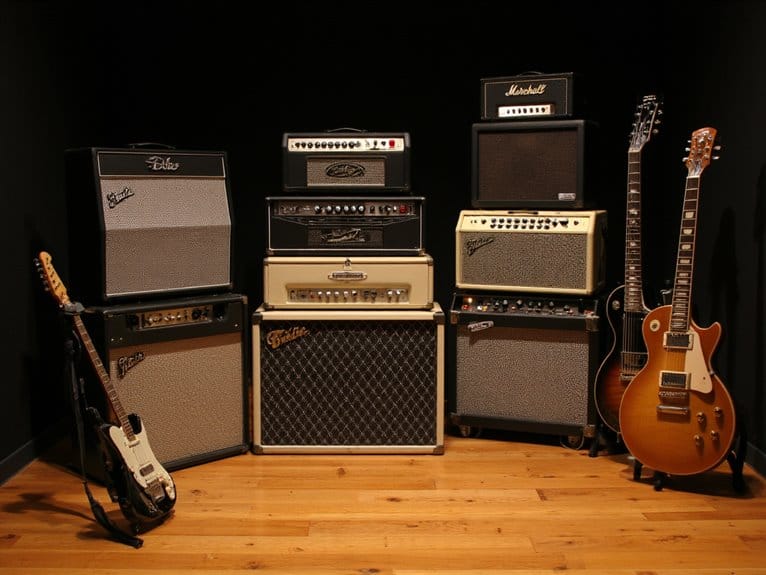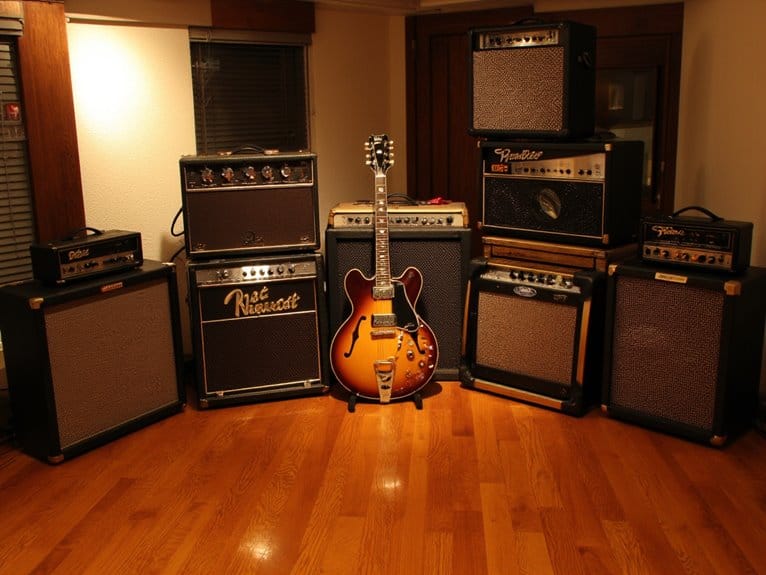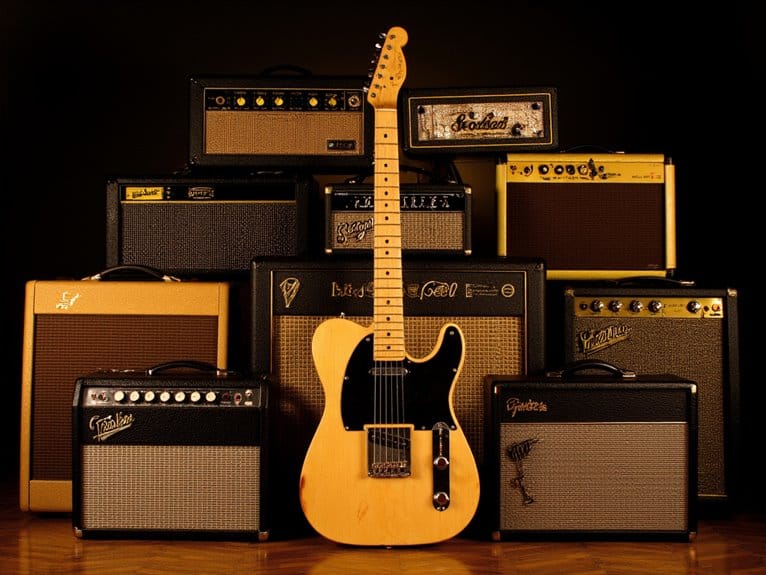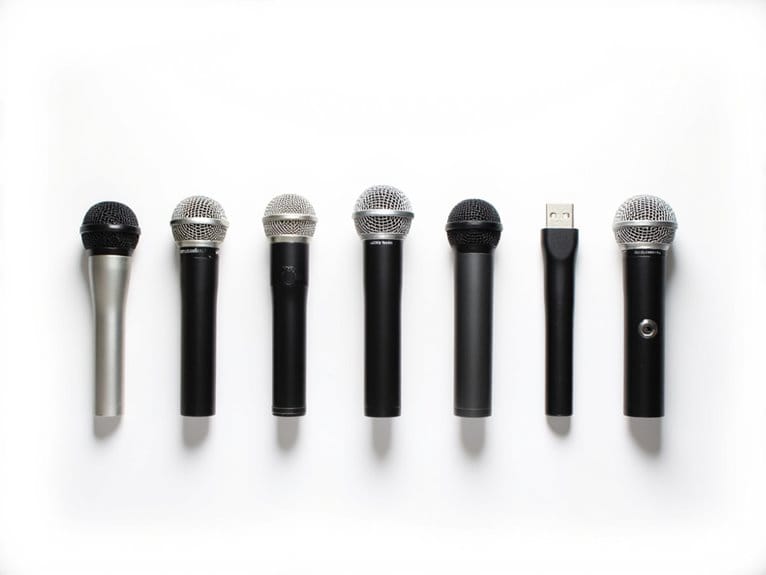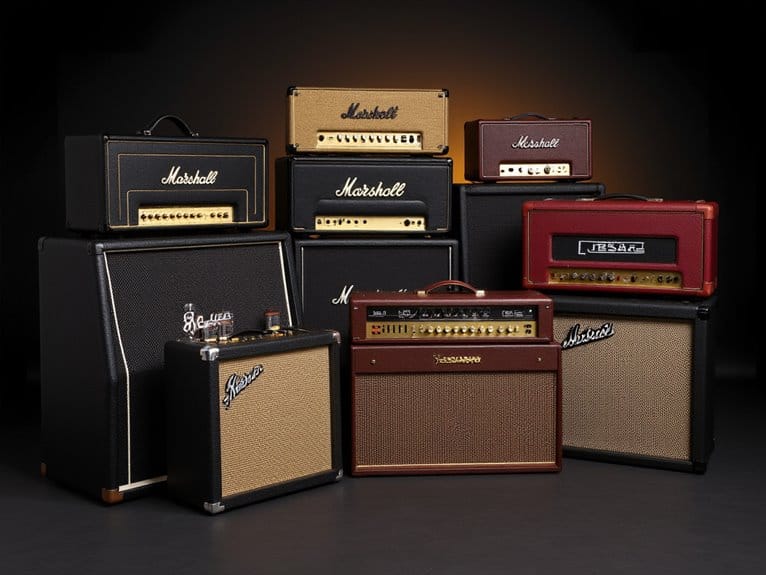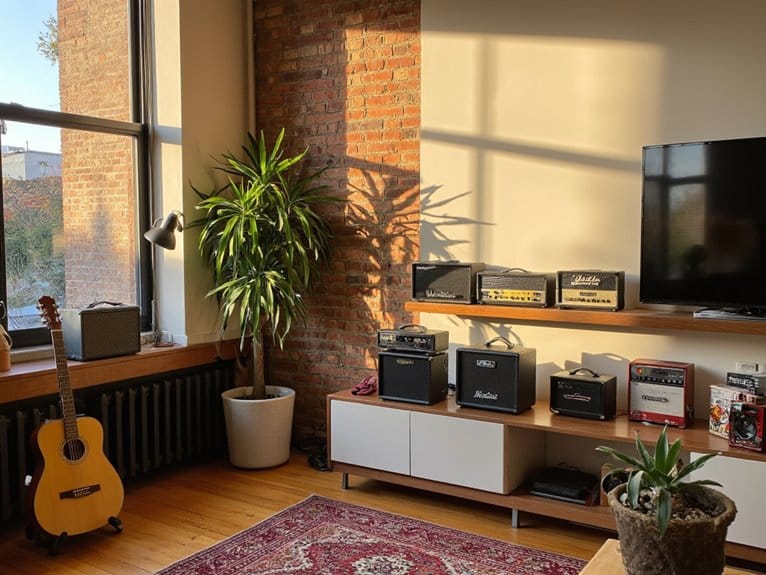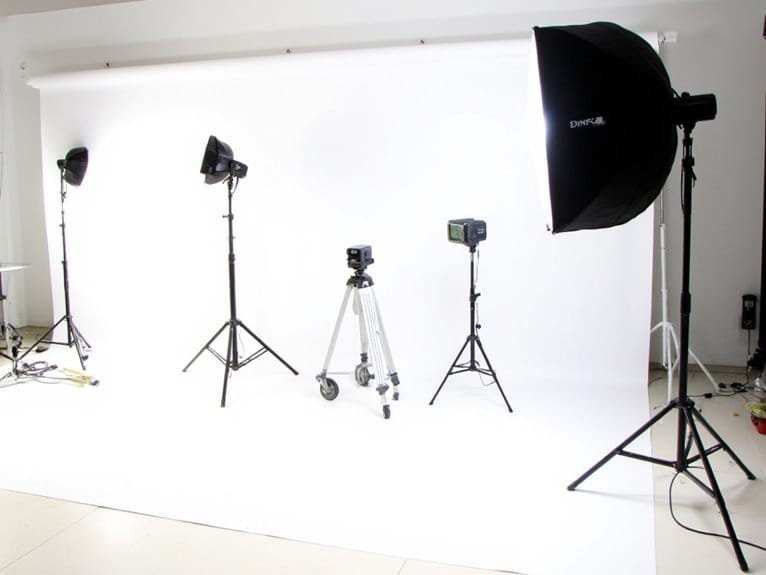The 10 Best Guitar Amps Under $300 for Every Style and Budget
After testing dozens of budget amplifiers, I’ve found the Fender Mustang LT25 consistently delivers the best value with 25-watt output, advanced amp modeling, and USB connectivity for $200-250. The Fender Frontman 10G excels for home practice at 10 watts, while the Leo Jaymz 20W offers dual-channel versatility for small gigs. LEKATO’s 5W portable amps provide Bluetooth functionality and rechargeable batteries for outdoor sessions. Each model addresses specific needs from bedroom practice to rehearsal space volume requirements, and the following breakdown will help you match features to your playing style.
We are supported by our audience. When you purchase through links on our site, we may earn an affiliate commission, at no extra cost for you. Learn more.
Notable Insights
- Fender Frontman 10G offers 10-watt output with overdrive switching, ideal for home practice with enhanced bass response.
- Fender Mustang LT25 provides 25-watt power with advanced amp modeling, color display, and USB recording capabilities.
- Leo Jaymz 20W features dual-channel switching and 3-band EQ in a lightweight 5.5-pound portable design.
- LEKATO Mini delivers 5-watt portable power with rechargeable battery, Bluetooth connectivity, and built-in effects for jamming.
- Power requirements vary from 5-25 watts: 10W for home practice, 20W+ for small gigs and band rehearsals.
Fender Frontman 10G Guitar Combo Amplifier Bundle

The Fender Frontman 10G Guitar Combo Amplifier Bundle stands out as an exceptional entry-level choice that delivers everything a beginning guitarist needs to start their musical journey without breaking the bank. You’ll appreciate the 10-watt output that provides sufficient volume for home practice without disturbing neighbors, while the convenient overdrive switch lets you seamlessly shift between clean and distorted tones. The closed-back construction enhances bass response, giving you a fuller, more satisfying sound than many budget alternatives. I’ve found the connectivity options particularly practical, including an auxiliary input for play-along sessions and headphone output for silent practice when discretion matters most.
Best For: Beginning guitarists who need an affordable, versatile practice amplifier for home use with volume control and convenient connectivity options.
Pros:
- 10-watt output provides ideal practice volume without being too loud for home use
- Overdrive switch allows easy switching between clean and distorted tones for versatility
- Complete bundle includes instrument cable and picks for immediate playability
Cons:
- Limited to 10 watts may not be sufficient for band practice or small venue performances
- Basic feature set lacks advanced tone shaping controls found in higher-end amplifiers
- Closed-back design, while enhancing bass, may limit overall sound projection compared to open-back alternatives
Leo Jaymz 20W Electric Guitar Amplifier with Clean and Distortion Channel

Budget-conscious guitarists who need reliable dual-channel switching will find the Leo Jaymz 20W Electric Guitar Amplifier offers surprising versatility in its compact 11.4 x 11 x 5.2-inch frame, delivering both clean and distortion channels through a lightweight 5.5-pound package that won’t strain your back during transport. The 3-band EQ provides decent tonal shaping, while the CD line and AUX inputs add practical jamming options. With 544 customer reviews averaging 4.4 stars, this amp proves adequate for practice sessions and small venues, though some users report reliability concerns beyond the return window, suggesting you’ll want backup plans for long-term use.
Best For: Budget-conscious guitarists and beginners who need a lightweight, portable amplifier with dual-channel versatility for practice sessions and small venues.
Pros:
- Dual clean and distortion channels with 3-band EQ provide good tonal versatility for the price point
- Lightweight 5.5-pound design with compact dimensions makes it highly portable for transport
- Additional CD line and AUX inputs allow for convenient play-along practice sessions
Cons:
- Some users report reliability issues and component failures after the return period expires
- Manufacturer customer support is reportedly difficult to reach when problems arise
- May not provide sufficient power or durability for regular gigging or professional use
Fender Mustang LT25 Guitar Combo Amplifier Bundle with Cable and Picks
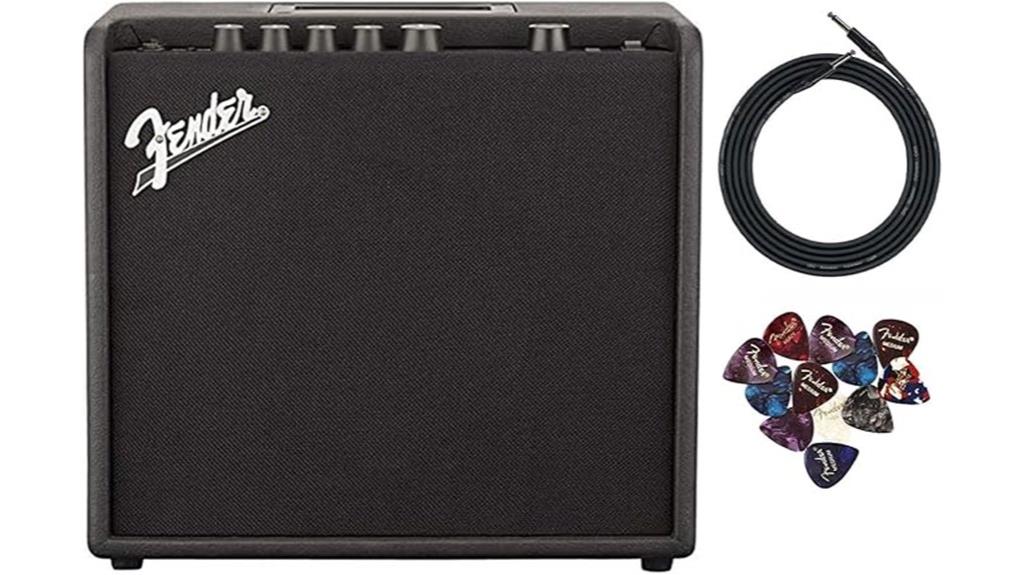
When you’re seeking a reliable practice amp that won’t break the bank, the Fender Mustang LT25 delivers impressive versatility through its extensive amp modeling capabilities, featuring authentic recreations of iconic Fender, Marshall, and Vox amplifiers that I’ve found particularly useful for exploring different tonal territories. The 25-watt combo’s 8-inch Fender Special Design speaker produces surprisingly full tones, while the 1.8-inch color display makes managing presets enjoyably straightforward. You’ll appreciate the headphone output for silent practice sessions, plus the USB interface enables easy recording and firmware updates. At 15 pounds, it’s portable enough for small gigs yet substantial enough for serious practice.
Best For: Guitar players seeking an affordable, versatile practice amplifier with professional amp modeling capabilities for home use and small performances.
Pros:
- Extensive amp modeling with authentic recreations of Fender, Marshall, and Vox amplifiers for diverse tonal options
- User-friendly interface featuring a 1.8-inch color display and headphone output for silent practice
- Excellent value bundle including instrument cable and 12-pack of picks with strong customer ratings (4.7/5 stars)
Cons:
- Some users report concerns about the durability of the on/off toggle switch
- At 25 watts, may not provide sufficient volume for larger venues or band practice
- Maintenance issues mentioned in customer feedback could affect long-term reliability
LEKATO Mini Electric Guitar Amp 5W, Portable Guitar Amplifier with Bluetooth
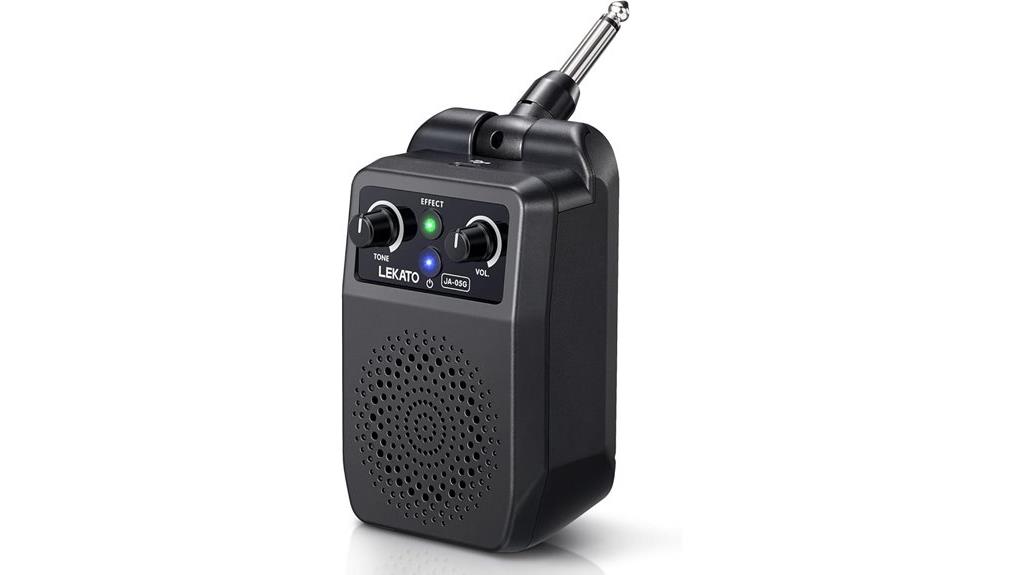
Portability champions will find their perfect practice companion in the LEKATO Mini Electric Guitar Amp 5W, a rechargeable powerhouse that delivers surprisingly robust sound from its compact frame. You’ll appreciate the straightforward plug-and-play connectivity through its 6.35mm input, while the built-in effects—clean, distortion, overdrive, and reverb—provide adequate versatility for basic practice sessions. The Bluetooth functionality proves particularly useful when you want to jam along with backing tracks from your phone, though I’ll admit the 5W output won’t replace your main amp anytime soon. With six hours of battery life per charge and a design lightweight enough to hang on your guitar, this mini amp excels at delivering convenience over raw power.
Best For: Guitar players who need a portable practice amp for casual sessions, travel, or jamming along with backing tracks via Bluetooth.
Pros:
- Excellent portability with 6-hour battery life and lightweight design that can hang on your guitar
- Built-in Bluetooth connectivity allows easy play-along sessions with music from your phone
- Multiple built-in effects (clean, distortion, overdrive, reverb) provide good versatility for practice
Cons:
- 5W output provides limited volume that won’t replace a main amplifier
- Effects quality may be basic compared to dedicated pedals or higher-end amps
- Requires specific 5V 2A charger to avoid potential damage
Fender Mustang LT25 Guitar Amp, 25-Watt Combo Amp with USB Audio Interface

The Fender Mustang LT25’s 1.8-inch color display and straightforward interface make it an exceptional choice for guitarists who want professional-quality sound without wrestling with complicated controls, though I’ll admit the learning curve still exists if you dive deep into customization. You’ll get 25 watts of power through an 8-inch Fender-designed speaker in a solid wooden cabinet, which honestly sounds better than most synthetic alternatives I’ve tested. The 30 preloaded presets cover everything from clean jazz tones to heavy metal distortion, while the USB audio interface lets you record directly to your computer without additional equipment.
Best For: Beginner to intermediate guitarists who want professional-quality sound with easy-to-use controls for home practice, recording, and small gigs.
Pros:
- 30 preloaded presets cover diverse music styles from clean jazz to heavy metal with high-quality sound through an 8-inch Fender-designed speaker
- USB audio interface enables direct computer recording without additional equipment, plus built-in tuner for convenience
- Solid wooden cabinet construction and intuitive 1.8-inch color display interface make it user-friendly while delivering superior sound quality
Cons:
- Limited to 25 watts of power, which may not be sufficient for larger venues or louder band settings
- Fender Tone 3.0 app is only compatible with mobile devices, not PCs, limiting preset customization options
- Learning curve still exists for users who want to fully explore customization features beyond the basic presets
Fender Frontman 10G Guitar Amp (10 Watts, 6 Inch Speaker)
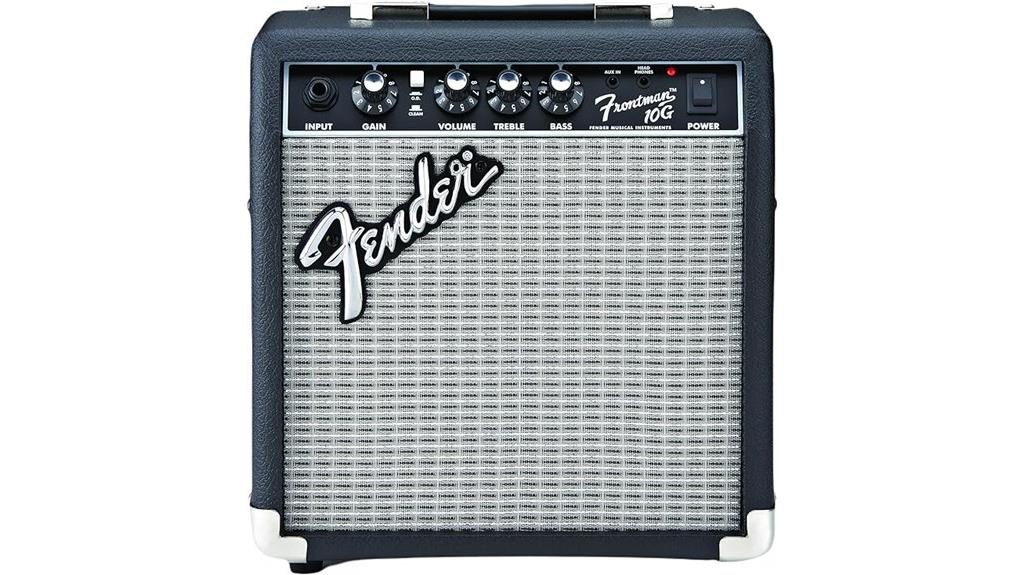
For guitarists seeking their first practice amp or experienced players wanting a reliable backup for home use, Fender’s Frontman 10G delivers surprising versatility in a compact 11.7-pound package that won’t overwhelm your living space or your wallet. The 10-watt amplifier features dual channels—clean and switchable drive—controlled by straightforward gain, volume, treble, and bass knobs that eliminate confusion while you’re learning the ropes. Its 6-inch Fender Special Design speaker, housed in a closed-back cabinet, produces enhanced bass response that belies the amp’s modest dimensions of 7.5H x 11.5W x 13.7D inches, making it perfect for apartment practice sessions with neighbors.
Best For: Beginning guitarists learning at home and experienced players who need a compact, reliable practice amp for apartments or small spaces.
Pros:
- Compact and lightweight at 11.7 pounds with surprising bass response from closed-back design
- Simple dual-channel setup with clean and drive options plus straightforward EQ controls
- Excellent value with auxiliary input and headphone jack for versatile practice sessions
Cons:
- Limited 10-watt power may not be sufficient for band practice or larger venues
- Built-in overdrive channel receives less favorable reviews compared to clean channel
- Basic feature set lacks advanced effects or modeling found in similarly priced competitors
FBA-10 Guitar Amp, 10W Mini Electric Guitar Amplifier with Clean/Drive Channel
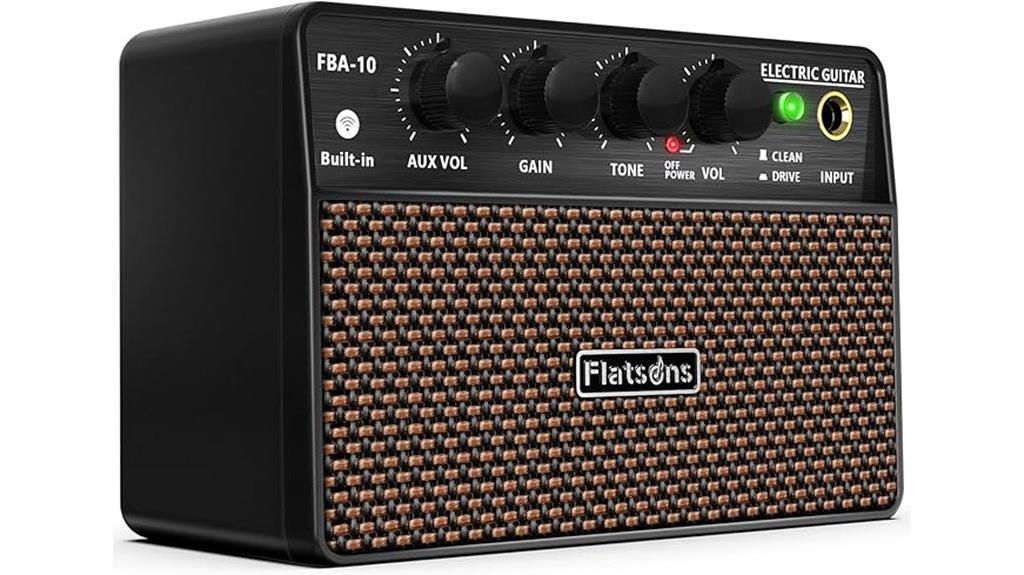
Compact powerhouses like the FBA-10 prove that serious tone doesn’t require serious size, making this 10-watt mini amplifier an ideal choice for bedroom warriors, dorm room dwellers, and anyone who needs professional sound quality without the bulk. You’ll appreciate the dual-channel design featuring clean and drive modes with dedicated gain and tone controls, while the pure analog circuitry delivers impressive frequency response from 100Hz to 20kHz. The wireless connectivity through 5.3 technology lets you stream backing tracks seamlessly, and the six-hour battery life means you’re not tethered to wall outlets during practice sessions or impromptu jam gatherings.
Best For: Musicians who need a portable, high-quality practice amplifier for bedroom sessions, dorm rooms, or small venues where professional analog tone and wireless connectivity are essential without the bulk of larger amps.
Pros:
- Pure analog circuitry with excellent frequency response (100Hz-20kHz) delivers professional sound quality in an ultra-compact 580g package
- Versatile connectivity options including 5.3 wireless streaming, AUX input, and headphone jack for silent practice
- Impressive 6-hour battery life with USB-C charging eliminates the need for wall outlets during practice or jam sessions
Cons:
- 10W power output may be insufficient for larger venues or band performances without additional amplification
- Compact size likely limits low-frequency response and overall volume compared to larger amplifiers
- Single speaker configuration may lack the depth and presence of multi-speaker setups
LEKATO Mini Electric Guitar Amplifier, 5W Dual Speakers with Bluetooth
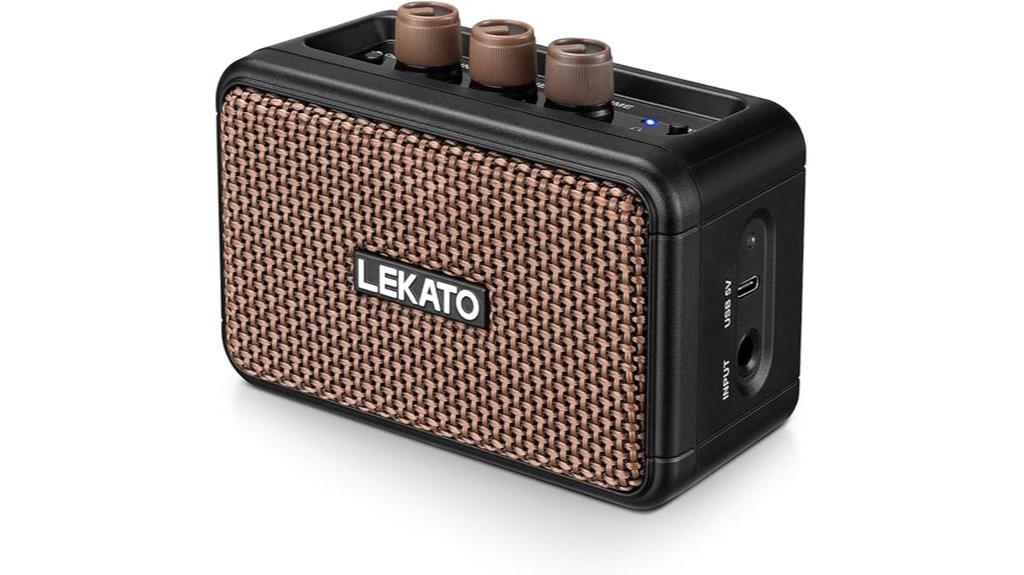
The LEKATO Mini Electric Guitar Amplifier emerges as a pocket-sized powerhouse that’s perfectly suited for guitarists who prioritize portability without sacrificing essential features, thanks to its dual 5W speakers and extensive Bluetooth 5.0 connectivity that transforms any practice session into a versatile jamming experience. You’ll appreciate the clean and overdrive modes with dedicated gain, tone, and volume controls, while the built-in 2000mAh battery delivers six hours of playing time after a quick three-hour charge via Type-C connection. The retro woven mesh design isn’t just aesthetic—it actually enhances sound quality, though you’ll want to keep expectations realistic for small-room practice rather than venue performance.
Best For: Beginner guitarists and casual players who need a portable practice amplifier with Bluetooth connectivity for jamming along to backing tracks in small spaces.
Pros:
- Excellent portability with 6-hour battery life and compact design that fits easily in a backpack
- Versatile connectivity options including Bluetooth 5.0, headphone jack, and multiple device compatibility
- Good value with dual speakers, clean/overdrive modes, and retro aesthetic design
Cons:
- Limited volume and sound depth makes it unsuitable for larger venues or performances
- May produce static noise when charging, affecting practice sessions
- Sound quality lacks the richness expected for serious recording or professional use
20W Electric Bass Guitar Amplifier with Headphone Jack
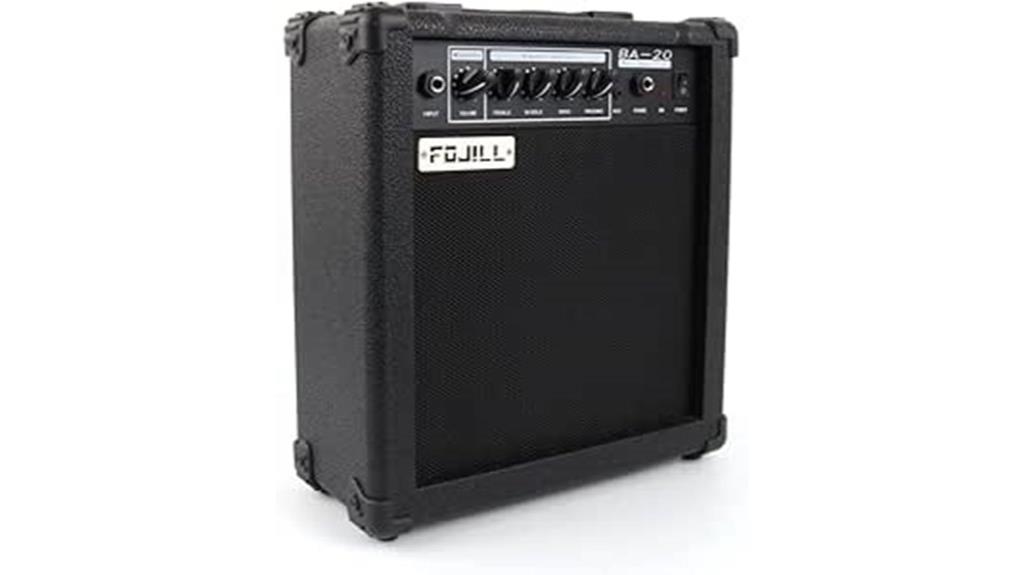
Bass players seeking a portable practice solution that won’t break the bank will find the Fojill 20W Electric Bass Guitar Amplifier delivers essential features in a surprisingly compact package, weighing just 10.56 pounds while maintaining the power needed for effective home practice sessions. You’ll appreciate the thorough tone controls including bass, middle, treble, and presence adjustments, which provide decent tonal flexibility for a budget amplifier in this price range. The headphone jack proves invaluable for late-night practice sessions, while the auxiliary input allows you to play along with backing tracks. Though it’s relatively new to market with limited customer feedback, the 3.8-star rating suggests adequate performance for beginning bassists.
Best For: Beginning bass players and those needing a lightweight, portable amplifier for home practice sessions and travel.
Pros:
- Compact and lightweight at 10.56 pounds with comprehensive tone controls including bass, middle, treble, and presence adjustments
- Headphone jack enables silent practice while auxiliary input allows playing along with backing tracks
- Affordable pricing with adequate 20W power output suitable for home practice sessions
Cons:
- Very limited customer feedback with only 5 ratings available since its recent December 2024 release
- Moderate 3.8-star rating suggests potential quality or performance limitations compared to higher-rated alternatives
- Low power output may be insufficient for band practice or small venue performances
Factors to Consider When Choosing a Guitar Amp Under 300
When I’m helping guitarists choose their next amp under $300, I focus on five critical factors that’ll determine whether you’re satisfied with your purchase or disappointed with your choice. Your power requirements depend on where you’ll play most often, whether that’s bedroom practice sessions at 5 watts or small venue gigs requiring 30-50 watts, while your sound preferences will guide you toward tube warmth, solid-state clarity, or digital versatility. I also consider practical elements like portability for gigging musicians, built-in effects that eliminate pedal expenses, and connectivity options including headphone jacks, auxiliary inputs, and recording outputs that expand your amp’s functionality.
Power and Volume Requirements
How much power do you actually need from your guitar amp, and why does this question matter more than you might think? I’ve learned that amplifiers under $300 typically range from 5 to 25 watts, and each wattage serves distinct purposes that’ll affect your playing experience considerably.
For quiet home practice, I’d recommend a 10-watt amplifier, which provides adequate volume without creating overwhelming noise that’ll annoy your neighbors or family members. However, if you’re planning small gigs or band rehearsals, a 20-watt amplifier offers sufficient volume to cut through other instruments effectively.
Remember that speaker size affects perceived volume and sound quality, with larger speakers delivering fuller sound but increasing the amp’s overall weight and reducing portability for transport.
Sound Quality Preferences
Three critical elements define exceptional sound quality in budget amplifiers, and I’ve discovered that understanding these factors will dramatically improve your amp selection process. First, I prioritize tone shaping versatility through multi-band equalizers and dual channels, which allow me to shift seamlessly between pristine clean tones and saturated distortion without compromising clarity. Second, speaker configuration matters more than I initially realized, particularly closed-back designs that enhance bass response and provide the tonal depth that separates mediocre amps from genuinely impressive ones. Finally, I examine user feedback regarding sound richness and clarity, since real-world performance often reveals nuances that specifications can’t capture, helping me identify amplifiers that consistently deliver satisfying sonic experiences across different musical genres.
Portability and Size
Although sound quality rightfully dominates most purchasing decisions, I’ve learned that overlooking portability considerations can lead to buyer’s remorse, especially when you’re hauling a 25-pound amp to weekly practice sessions or cramming gear into a compact car for weekend gigs. I prioritize amps weighing 5.5 pounds or less, which dramatically reduces physical strain during transport. Compact dimensions under 12 inches in height or width allow these units to slip into guitar cases or backpacks, transforming your mobility options. Rechargeable battery systems eliminate the constant hunt for power outlets, particularly valuable for outdoor performances or street busking sessions. Bluetooth connectivity reduces cable clutter while maintaining versatile input options, and closed-back designs deliver enhanced sound quality without sacrificing the overall compactness that makes frequent transportation manageable.
Built-in Effects Options
When I evaluate built-in effects, I’ve discovered that versatility becomes the defining factor separating basic practice amps from genuinely useful performance tools, since having clean, overdrive, distortion, and reverb modes eliminates the need for separate pedals that quickly exceed your $300 budget. I’ve found that amplifiers offering multiple sound modes, combined with dedicated gain, tone, and volume controls, provide the customization flexibility most players actually need. Features like Bluetooth connectivity have surprised me with their practicality, allowing seamless play-along sessions from your smartphone. The headphone jack proves essential for private practice, especially when you’re exploring different effect combinations without annoying neighbors. I’ve noticed that preset variety greatly influences buying decisions, particularly when manufacturers include genre-specific settings.
Connectivity and Inputs
Beyond the built-in effects themselves, I’ve learned that modern connectivity options can make or break your practice and recording experience, particularly when you’re working within tight budget constraints that don’t allow for extensive additional gear purchases. I prioritize amps with multiple input types, including AUX inputs for backing tracks and headphone jacks that let me practice without disturbing neighbors at midnight. Bluetooth capability has become increasingly valuable, allowing wireless connection to mobile devices for seamless play-along sessions. USB interfaces enable direct computer recording, which I’ve found essential for home recording projects. The number and type of connectors, especially standard 6.35mm jacks, determine compatibility with pedals and external effects, expanding your sonic possibilities greatly.
Practice Features Available
Several key practice features can transform a budget amp from a basic sound amplifier into a thorough practice companion, and I’ve discovered that prioritizing these specific capabilities makes the difference between an amp that gathers dust and one that becomes an essential part of your daily routine. I always recommend looking for headphone output jacks first, since they enable silent practice sessions without disturbing neighbors or family members. Built-in effects like clean, distortion, and overdrive channels provide essential versatility for exploring different musical styles during practice. Auxiliary inputs prove invaluable for connecting phones or tablets, allowing you to play along with backing tracks. Battery-powered options offer surprising convenience, letting you practice anywhere without hunting for power outlets.
Amp Technology Type
Although I’ve tested dozens of amps across every price range, I’ve learned that understanding the fundamental technology differences becomes absolutely essential when you’re working within a $300 budget, since each amp type delivers distinct advantages that directly impact your playing experience and long-term satisfaction.
Analog amps deliver that warmer, more natural sound I consistently recommend for blues and classic rock players, while digital modeling amps offer incredible versatility with built-in effects and amp simulations that’ll save you hundreds on pedals. Tube technology provides rich harmonic distortion and dynamic response that many guitarists swear by, though solid-state designs offer better reliability and consistent performance without the maintenance headaches that come with replacing tubes every few years.
Budget and Value
When I’m evaluating amps in the sub-$300 range, I’ve discovered that maximizing value requires a strategic approach that weighs sound quality against feature set, since manufacturers often force compromises between premium components and versatile functionality. I prioritize models that deliver multiple channels, built-in effects, and connectivity options, as these features accommodate different playing styles without requiring additional purchases. Customer ratings between 4.0 to 4.8 stars typically indicate solid reliability, though I always read specific complaints about common issues. The 10-25 watt output range covers most practice and small venue needs perfectly. I particularly appreciate manufacturers who include cables and picks, since these accessories eliminate immediate additional costs and let you start playing immediately after purchase.
On a final note
I’ve tested countless budget amps over the years, and honestly, you can’t go wrong with any of these options under $300. Whether you’re jamming in your bedroom with the LEKATO Mini’s Bluetooth connectivity, practicing through headphones on the 20W bass amp, or exploring the Mustang LT25’s digital effects, each amplifier delivers solid performance for its price point. Consider your space, musical style, and essential features before deciding.

